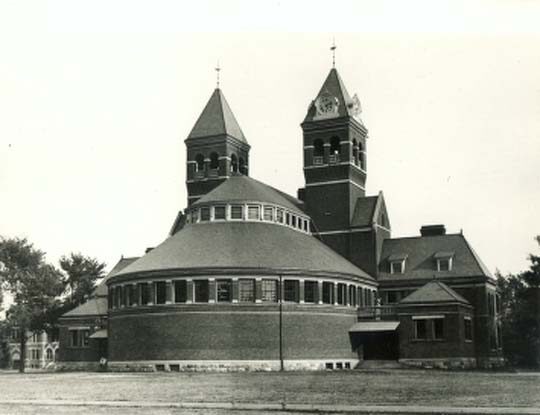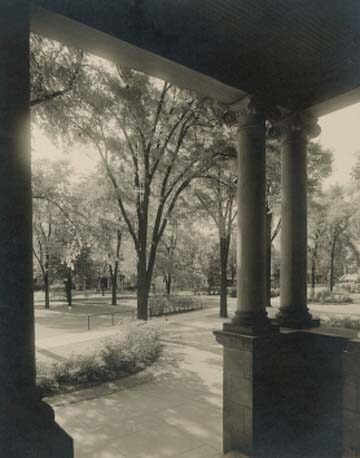It’s all there in black and white
In 1913 the University of Michigan hired its first staff photographer, 1897 alumnus George Robert Swain. He went on to complete a graduate degree in 1914. Thanks to Swain’s comprehensive coverage of campus, we have a vivid visual record of our shared history.
-
JAG drill and formation
Swain was an accomplished world traveler who once followed the route of Caesar’s army through Switzerland, France, Belgium, and England photographing the actual sites of the Gallic campaign. Here he captured members of the Judge Advocate General’s School, engaged in a drill in the Law Quadrangle before they left campus to embark on their own military adventures. One explanation for Swain’s love of global exploration may lie in his youth. “Between the ages of 12 and 16, I read a great many books on travel and adventure,” he wrote, including all of James Fennimore Cooper’s work, “and whatever stories about hunting I could lay my hands on.”
-
The Diag
Swain wrote several essays, shorts stories, and poems related to Ann Arbor scenery. His piece “Where the Chimes Carried Me” opens at dusk on an autumn evening. The writer is “sauntering along the diagonal walk” when he hears the music of nearby chimes. He travels in his mind to scenes of his youth in New Hampshire and California. But as the chimes stop, so does his reverie. “Chill lowers the grey sky overhead,” Swain writes, “and through the naked trees whistles the cutting November wind. Turning up my collar and quickening my steps, I hasten my way through the gathering darkness.”
-
Scholar
This sculpture, known as “Scholar” sits above the front entrance of the Michigan Union. Swain’s log identifies the men here as Pond and Murphy. Swain himself worked as a teacher and high school principal before joining the U-M staff. On what appears to be an application detailing his professional credentials, he displayed a dry wit: “Central New Hampshire chiefly. Five years in California directly previous to entering [the University of Michigan], which may have caused ‘minor peculiarities.'” One such peculiarity may have been his love of biking. Swain cycled about a thousand miles through the Rockies and Canada collecting photos of geological wonders for use in his classroom.
-
University Hospital
This building, part of the original Catherine Street Hospitals, served as a psychopathic hospital. At different times it was known as East Hospital and Beal Residence. The building was torn down in 1965, but it may be the site referenced in Swain’s short story “While She Slept.” In the piece, the male character, Allitsen, has given female Bernadine his old camera, complete with “acid comment” regarding her lack of technical prowess. Later, Bernadine dreams she is walking in Ann Arbor, “camera in hand, disagreeable man at her side.” As she prepares to photograph a medical building, she asks for Allitsen’s help. “Turn that screw with the large head to the right,” he says. “No, not that way. The other. Did a woman ever know the first thing about machinery?”
-
Canoe on the Huron
Swain was a prolific writer and seemed to enjoy poetry, in particular. He wrote this beautiful ode to autumn titled “Where Would I Walk with Thee” that could easily have been set along the Huron River: “In the autumn woods where the sunlight glints; through its myriad leaves of a thousand tints; and the pathway leads ‘mongst the tree trunks grey; by a hurrying brook that seems to say, ”Tis a beautiful world I’m rippling through; and I love it well. Don’t you? Don’t you? There ‘twould be joy for me, could I but walk with thee.'”
-
The School of Music
The original School of Music was based in a building on Maynard Street before moving to North Campus. Swain himself dabbled in music, but ultimately favored photography as his creative medium. “Although I play an organ but little, I have been told I have a very expressive touch,” he reflected. “Work in outdoor photography the last half dozen years has developed a strong liking for pictures, and sharp observation in noting effects in light and shade. I might almost say that it has opened a new world of enjoyment to me.”
-
Progress
Construction—or should we say reconstruction—has been a constant on the University campus since ground was first broken nearly 200 years ago. Here the original library undergoes a facelift at the turn of the 20th century. Though an addition to the building had been finished in 1898, the 1883 portion of the building (pictured here) was razed in 1918. This is one of the few “action shots” to be found among Swain’s extensive collection.
-
The old library
The original library once occupied the site where the north building of the Harlan Hatcher Graduate Library stands today. The original building was declared unsafe in 1915 and it was removed—save the fireproof bookstacks—in 1918. In his description of the library, Swain seemed most captivated by the majestic Tappan Oak, which stood just west of the main entrance. “Its shape,” the photographer wrote, “is far more symmetrical than that of most oaks, but whether this is due to the scholastic atmosphere or to the saw of the tree trimmer might be in question … Perhaps it is not too much to say that the tree impresses one as an existence that has fought its way upward in the face of obstacles, not passing through its conflicts unscarred, yet ever reaching heavenward, attaining strength and sturdiness through opposition.”
-
The engineering shops
In 1885 demand for the education of engineers was so great the Regents authorized construction of a laboratory to augment classroom instruction. The West Engineering Annex, first occupied in 1886, was removed in 1956 to make room for the undergraduate library. Swain stuck to the facts when he wrote of the building: “Picture to yourself a tower rising from the eaves of a building, supported by a sub-structure extending to the ground, constructed of red brick with gray sandstone trimming, rectangular in cross-section, rising vertically for about three-fifths its height, and crowned by a pyramid slated roof, each of whose four steep sides has the same angular slant, and whose wedge-like summit is completed by an ornamental iron crest.”
-
University Hall
Swain took great pains to describe University Hall in tremendous detail in his essay “The Most Pretentious Facade on the Campus.” The building, constructed in 1871, connected Mason Hall and South College, forming one grand centerpiece for the University. Beset with controversy from the onset (mostly regarding the design and appearance of its dome), the building was demolished in 1950. It is difficult to tell Swain’s intent for the term “pretentious” since his assessment reads as a neutral itemization of the columns, porticos, balustrades, and arches that comprised the building.
-
The original Haven Hall
Swain was meticulous and disciplined in his use of language to describe visual scenes. “Any description that appeals powerfully to the reader’s imagination and has enough points of contact with his previous experience to raise in his mind a vivid picture almost as real as the actuality—any description that does this, I say, is an excellent one.” Haven Hall was an early home to the Law School and was known commonly as “the old Law Building.” When Law moved to Hutchins Hall in 1933, the building was renamed in honor of Erastus O. Haven (U-M president from 1863-69) and became one of the major buildings of the College of Literature, Science, and the Arts. Built in 1863, it burned to the ground in 1950.
-
On location
Swain (far left) often accompanied U-M professor and archaeologist Francis Kelsey (black suit) to Europe and the Middle East, collecting so many images that The Detroit Free Press once described him as a “supreme camera fiend.” In addition to his career as campus photographer, Swain was a prolific writer and aspiring linguist. He kept a detailed journal of his travels, wrote poetry and short stories, and penned a number of essays regarding the evolution of the English language. This rare shot of Swain in front of the camera was taken in Egypt’s Kom Aushim on Christmas day 1926.













